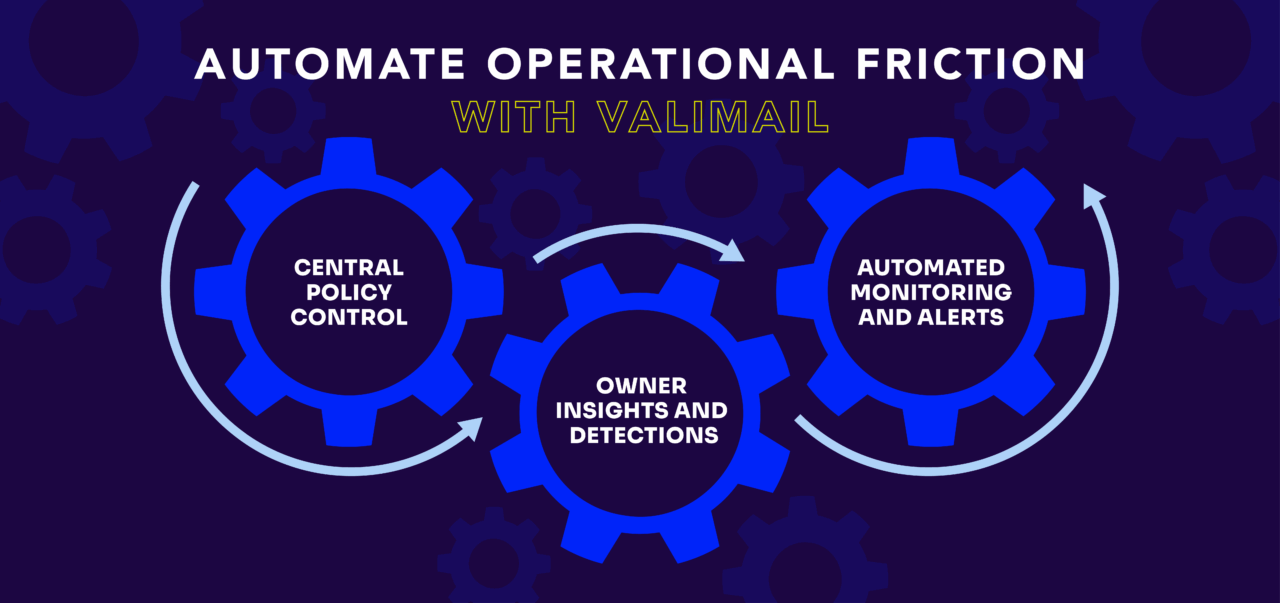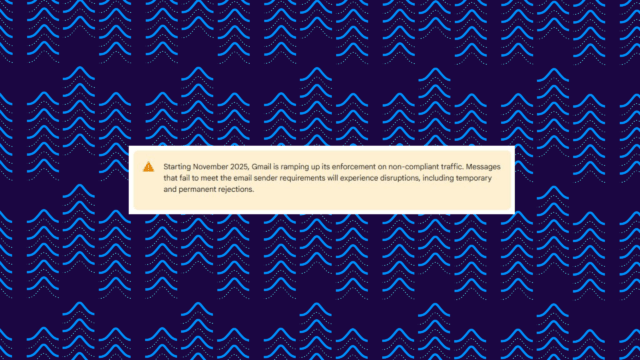Managing DMARC for a single domain is challenging enough. Now multiply that by dozens or hundreds of domains, thousands of legitimate sending sources, constant organizational changes, and strict compliance requirements.
This is what enterprise security teams have to deal with, and manual DMARC management simply doesn’t scale. Identifying every email service across multiple business units, manually updating DNS records, monitoring authentication failures, and maintaining enforcement policies becomes a full-time job (or several).
This leads to most enterprises either never reaching DMARC enforcement or taking years to get there, leaving their domains vulnerable to spoofing and phishing in the meantime.
Automated DMARC configuration solves this problem. It handles the complexity, scales effortlessly across your entire email ecosystem, and gets you to enforcement faster. And best of all, it doesn’t require an army of engineers or eat up your security team’s bandwidth.
What is DMARC enforcement?
DMARC enforcement is the state where your DMARC policy is set to either quarantine or reject, instructing mailbox providers to block or filter emails that fail authentication. This is the point where DMARC shifts from monitoring to active protection against domain spoofing and phishing.
DMARC has three levels:
- Monitor (p=none): You’re collecting data about who’s sending email using your domain, but not taking any action. Failed emails still get delivered. This is useful for visibility, but it doesn’t actually protect you.
- Quarantine (p=quarantine): Emails that fail DMARC authentication are sent to spam folders. This provides some protection while still allowing recipients to check their spam if needed.
- Reject (p=reject): Emails that fail DMARC are blocked entirely and never reach the inbox. This is full enforcement and maximum protection.
The challenge is getting to enforcement safely. Before you can set your policy to quarantine or reject, you need to identify every legitimate sending source and double-check that they’re all properly authenticated. Miss even one service, and legitimate emails get blocked, and that’s why most enterprises get stuck at p=none indefinitely.
DMARC enforcement is where real protection happens, though. It’s what stops attackers from impersonating your domain, protects your brand reputation, and meets compliance requirements.
Why it’s so difficult to maintain enterprise DMARC enforcement
Enterprise DMARC enforcement isn’t just harder than small business DMARC—it’s a completely different challenge. Here’s why most large organizations struggle:
- Scale makes everything exponentially harder. You’re not managing one domain. You’re managing dozens, hundreds, or even thousands across multiple brands, subsidiaries, and regions. Each domain has its own set of sending services, authentication requirements, and stakeholders. What works for your main corporate domain might not work for your regional offices or acquired companies.
- Hundreds of legitimate senders to identify. Enterprise organizations use countless services that send email: marketing platforms, CRMs, helpdesk tools, HR systems, notification services, transactional email providers, and more. Different departments use different tools, often without coordinating with IT or security. Identifying every single legitimate sender across your entire organization is like finding needles in a haystack…except there are thousands of needles and the haystack keeps growing.
- Constant organizational change. Companies acquire other businesses. New departments spin up. Teams adopt new SaaS tools. Services get replaced or retired. Every single change impacts your email authentication, and if your DMARC configuration doesn’t keep pace, something breaks. Either legitimate emails get blocked (because you removed a service that’s still in use) or your protection weakens (because new services aren’t properly authenticated).
- Compliance and regulatory requirements. Many industries require DMARC enforcement as part of their security standards. Financial services, healthcare, government contractors—they all face mandates that include email authentication. But meeting those requirements manually means dedicating significant resources to DMARC management, often pulling security staff away from other priorities.
- Limited resources and competing priorities. Your security team is already stretched thin. They’re dealing with vulnerabilities, incidents, compliance audits, and a dozen other urgent issues. Manually managing DMARC across hundreds of domains is something most organizations simply don’t have the headcount to do.
Manual DMARC management doesn’t scale. Enterprises that try to manage DMARC manually either never reach enforcement or spend years getting there, and that leaves their domains vulnerable the entire time.
How DMARC automation solves the issue(s)
Automation transforms DMARC from a resource-intensive manual process into a scalable, efficient system that actually keeps pace with enterprise complexity. Here’s how DMARC automation helps an enterprise reach (and maintain) DMARC enforcement:
- Automated service discovery eliminates the guessing game. Automated DMARC solutions scan your email traffic and identify senders automatically. They translate raw IP addresses into recognizable service names (like “Salesforce” or “Mailchimp”) so you know exactly who’s sending and can authorize them with a single click.
- One-click authorization replaces ticket workflows. When a new service needs to be added, there’s no IT ticket, no DNS changes, no waiting. Authorized users simply click to approve the service, and the system handles SPF and DKIM configuration automatically.
- Continuous monitoring catches changes in real-time. Automation continuously monitors your email traffic for new senders, authentication failures, and potential threats. If a new service (legit or not) starts sending email using your domain, you’re alerted immediately.
- Centralized management across all domains. Automated platforms give you a single dashboard where you can manage authentication for your entire email ecosystem. Set policies, authorize senders, and monitor status across hundreds of domains from one place.
- Policy enforcement that scales. Moving from monitoring to enforcement doesn’t require massive coordination efforts. Automated systems let you gradually enforce DMARC across your organization—starting with low-risk domains, then expanding to others as confidence builds.
- Audit trails and compliance reporting are built in. Every change is logged automatically. Every authentication attempt is recorded. When auditors ask about your email security posture, you have comprehensive reports ready to go.

How Valimail automates DMARC at enterprise scale
Valimail Enforce is built for enterprise complexity. The platform automatically identifies sending services from a database of over 70 million pre-decoded IP addresses, so you instantly see who’s sending email using your domains without any manual detective work.
One-click authorization replaces the entire DNS ticket workflow. When marketing needs to add a new service, they authorize it in Valimail, and authentication updates happen automatically.
No IT bottleneck, no manual DNS changes, no delays.
Valimail’s patented Instant SPF technology eliminates the 10 DNS lookup limit, so enterprises can authorize unlimited sending services without breaking SPF. And as the only FedRAMP-certified DMARC provider, Valimail meets the strictest government and compliance standards.
Our solution helps enterprises reach DMARC enforcement four times faster than with manual approaches or competing solutions (often within 45 days instead of taking years). That’s automated email authentication that actually scales.

Automate your DMARC enforcement with Valimail
Manual DMARC management at enterprise scale is unrealistic. The complexity, constant changes, and resource demands make enforcement nearly impossible without automation.
Valimail Enforce eliminates the manual work. Automated sender discovery, one-click authorization, unlimited SPF lookups, and continuous monitoring mean your security team can finally focus on strategic priorities instead of drowning in DNS tickets and DMARC reports.
Stop letting DMARC sit at p=none while your domains remain vulnerable. Automate your path to enforcement and protect your brand without the extra work.
If you’ve been struggling with DMARC fails and troubleshooting email authentication, we’re here to help! You can book a free consultation with us to walk through any of your issues, and we’ll provide advice and guidance on how to overcome them.
Ready to make progress on your DMARC project? Get guidance on your next step.

Frequently asked questions about automating DMARC for enterprises
Q. How long does it take to reach DMARC enforcement with automation?
With Valimail, most enterprises reach enforcement in 45 days or less. Compare that to manual approaches, which typically take 12-18 months (if organizations reach enforcement at all). The difference comes down to automated sender discovery and one-click authorization, which eliminates the months-long process of identifying services and coordinating DNS changes.
Q. Will automation work with our existing DNS provider?
Yes. Valimail uses CNAME delegation, which means you don’t need to switch DNS providers or give up control of your DNS infrastructure. You create a single CNAME record pointing to Valimail, and all email authentication records are managed through Valimail’s platform while your existing DNS setup remains unchanged.
Q. What happens to legitimate emails during the transition to enforcement?
Valimail’s approach ensures that legitimate emails continue to flow. That’s the whole point, after all. The platform identifies all your authorized senders before you enforce policies, and you can gradually move to the enforcement domain by domain. You maintain complete control over the timeline and can test thoroughly before blocking any email.
Q. Can we manage DMARC for acquired companies through the same platform?
Absolutely. Multi-domain management is built specifically for this scenario. When you acquire a company, you add its domains to Valimail and gain immediate visibility into its email ecosystem. You can then standardize authentication policies across the organization or maintain separate configurations as needed.
Q. Do we need dedicated staff to manage the platform?
No. That’s the beauty of automation. While you’ll want someone to oversee the program and make authorization decisions, Valimail eliminates the need for dedicated DMARC administrators. Most enterprises manage their entire email authentication program with existing security or IT staff.



